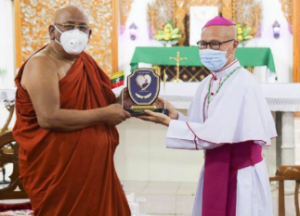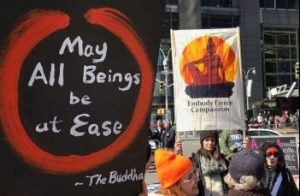
Editor’s note: This feature was first published in the now-retired Bodhi Journal, Issue 1, October 2006.
Preamble
As a third generation Catholic taught by missionaries since elementary school, I have been taught to have genuine respect for other people’s religions without feeling apologetic about being critical about certain practices. When I had the opportunity to join the Buddhist Pilgrimage Tour to Sri Lanka this summer, I therefore decided to look at how present-day Sri Lankan Therav?da Buddhists show their devotion.
The six day pilgrimage was packed with visits to ancient Buddhist sites and relic-chambers, and sessions on meditation and P?ja. Frankly, the bare-footed walks and the spicy foods were tough ordeals for me. Nevertheless I was deeply moved by the naturalistic life-style and practices of the Sri Lankan Buddhists. This short article thus contains cursory reflections of Sri Lankan Buddhist customs and, in particular, devotional practices that I experienced and observed in the course of my Pilgrimage.
Homage with Flowers and Incense
My first experience of Therav?da devotion came with the visit to the Avukana Buddha. We bought bunches of lotus flowers from some peddlers and, imitating the local worshippers, walked up bare-footed to the altar and offered a single flower. In the following days, I noticed the local people always broke off the stem and disposed of it away from the immediate vicinity of the Buddha image. The altar was usually a wooden table or a marble slab, undecorated and kept neat and clean. Offerings included other flowers, such as the jasmine. Some women would offer trays of florets, but men would cup their hands and offer only as many as they could hold. I noticed some men took off the lotus petals one by one and rearranged them into a flower on the altar. Their gentleness inspired me to follow their example.
And from that gesture I started wondering –could it be that the state of our mindfulness during that simple act would bring us closer to a realization of our inter-dependence, our mutual impermanence, even in ignorance of the beautiful P?ja:
I offer thee, Lord Buddha, these flowers.
May this virtue aid in my emancipation.
Our bodies undergo decay,
Even as these flowers must fade
Just before reaching the Avukana Buddha we saw a simple brick structure described as a “Multi-Function Building”. Inside were rows of rough tables and benches. At the time of our visit (around mid-day), a group of about 30 students around 10 years of age seemed to have just finished class and were playing. The guide told us that the building served as a classroom, a venue for dhamma talks, village assemblies and other collective activities. There was no wiring for light or sound, yet the minimalist building plays out the intellectual and emotional aspects of the Dhamma.
At the Anuradhapura dagabas (st?pas), we came upon an evening offering procession. A single drummer led the long queue of men and women, who were all dressed in white. They were holding up trays of fresh flowers or something saffron-colored, perhaps robes for Sa?gha members, and chanting softly as they moved towards the Relic-Chamber. Other local worshippers stood quietly by the side, some holding a single burning incense-stick, from which a pleasant fragrance ensued. I felt the sanctity of the occasion and wished I could share in their devotion.
Reverence for Bodhi-Trees
The biggest crowds were found at the Mah? Bodhi-Tree Garden, yet there was neither hustle nor bustle as they circled the sacred branch. Some pilgrims, including Sa?gha members, were seated out of the way of the circling throngs, deep in meditation. Men and women, old and young, were sitting at various spots on the ground and reading aloud from Sinhalese sheets. This Bodhi-Tree is said to have grown from a branch of the tree under which the Buddha gained Enlightenment. It was planted 2250 years ago and is the oldest historic tree in the world. I observed similarly popular Bodhi-trees which were said to have originally been saplings taken from that same branch and grown at other vih?ras.
The local guide told us that Sri Lankan Buddhists venerated the Bodhi-tree more than Buddha images. I wonder if this practice stems from a genuine belief in the very essence of the Buddha’s teaching that worldly people should cultivate Bodhi to attain enlightenment? We were asked not to pluck fresh leaves from the Bodhi tree. It was alright to pick up fallen ones, but one would have to look out for falling leaves because a cleaner was constantly sweeping away leaves that had landed. I also noticed that the water that was offered to the Bodhi-tree was first filtered before it was reverently poured at its roots. The filters were simple cloth bags tied around the taps. The brownish slurry in the bags indicated their intention was more likely to remove silt that would damage the roots of the Bodhi-tree, rather than to remove the micro-sentient beings in the water!
Bodily Conduct in the Acts of Veneration
Regarding the veneration of Buddha images, all Buddhist sites carry admonitions like: “Remove your shoes”, “Ladies should not wear mini-skirts nor tops with straps [i.e. not show bare shoulders]”, and “Do not take photographs with your back to the Buddha [image]”.
At the ancient palace grounds, I was keen to see if there would be a route behind the Buddha statute where one could do walking meditation. I forgot the rule, had a quick snapshot of myself in front of the statue and went behind it for my walk. When I came away, some distance from the Buddha image, a guard came forward and “showed” me the offence I had committed. He told me to make a donation. He pointed to a Donation Box (which was much, much bigger than the modest ones commonly located in front of Buddhist relic-chambers), situated about 50 metres away, outside the foundation wall enclosing the site and behind some bushes. How much should we give? The same reply, “As you like”, was given by most of the peddlers who sold us flowers and from the attendants who kept watch over our shoes.
Glamour in Therav?da Buddhism
Apparently, Therav?da Buddhism does not provide much in the way of rites and rituals. But Buddhism in Sri Lanka is not without glamour. We arrived during the annual 10-day festivities of Perahera (Procession) at Kandy. The lit-up nightscape provided a stunning spectacle, as did the dazzle of gold and silver on the temple interiors and the lavishly embroidered jackets and pantaloons of the “temple guardians”. Through the worldly wisdom of our guides, we were given VIP treatment at the Dalada Maligawa, theTemple of the Sacred Tooth (a temple containing one of the teeth of the historical Buddha). We were admitted into a richly-decorated alcove housing the st?pa of the Sacred Tooth and had the great honor of being allowed to hold several precious museum pieces in our hands. Later the doors of the alcove were momentarily opened to allow worshippers from the outside to catch a glimpse of the st?pa.
Due to a tight schedule, we could not stay for the whole Procession and missed the famous retinue of decorated elephants that would have played a part in a royal homage to the Tooth Relic.
On Sunday evening we stayed at the Bangledash Vihara. I returned early from a short shopping spree and, not wanting to disturb the novices in their sparsely-furnished rooms, waited under the Bodhi-tree for the main party to return. A young man sat at a corner, away from the walk-way, motionless in his dhyana (meditative state). Soon worshippers started coming in. Some came empty-handed, some carried handfuls of florets; a few drove in and two matronly ladies, in elegantly-embroidered white clothes, had chauffeurs. When the bell sounded three times at seven o’clock, the young man got up and left, apparently oblivious to the young ladies gathered in front of the P?ja Hall. The evening P?ja began, each worshipper taking turns to offer trays of flowers and bottled liquids. They then sat down for a Buddhist chanting session; some on the patio, some on the steps, some leaned against the handrail and one young lady seated herself gracefully on the banister, but no worshipper fussed about adopting any particular posture or facing any particular direction.
The whole service was so natural and its participants so at ease. I almost forgot I had to board the bus for an appointment with Professor Karunadasa and his wife at their home in Colombo.
Paying Respects
Professor Y.Karunadasa invited us to dine at the Raja Bojun Restaurant. We could hear deafening pop-music on the garage floor. It turned out there was a wedding party on the main floor and guests in dinner jackets and evening dresses were coming and going.
The view of Colombo from the 11th floor was magnificent. Venerable Dhammap?la, who accompanied us on our trip and drank just a bottle of juice for dinner (Therav?da monks are not to eat after noon), sought the Professor’s comments on the influence of Therav?da Buddhism in modern Sri Lanka. Professor happily agreed to provide some articles.
I caught myself wondering – wouldn’t it be a beautiful act of pupilage to pay our respects to our Professor as we do members of the Sa?gha? I do not know if the five-point prostration is observed for Sa?gha members only, but I do know there is a tradition for junior members in Chinese families to kneel, bow and offer (sweet) tea to elders on special occasions such as New Years’ Eve and birthdays. I have also been told there is a similar tradition in Myanmar, another Therav?da country.
These acts of respect always open a well-spring of spontaneous joy within me. I dare say I was not the only one who did not understand the Pali benedictions the Venerables were chanting, but I am sure we all felt the good-will of their concluding blessing: “Have a safe journey home”.
In conclusion, may I invite you, my readers, to share in the attainments of this pilgrimage:
I salute every cetiya (shrine)
That may stand in any place
The bodily relics, the Great Bodhi
And all images of the Buddha
I wish you all: AYUBOWAN











